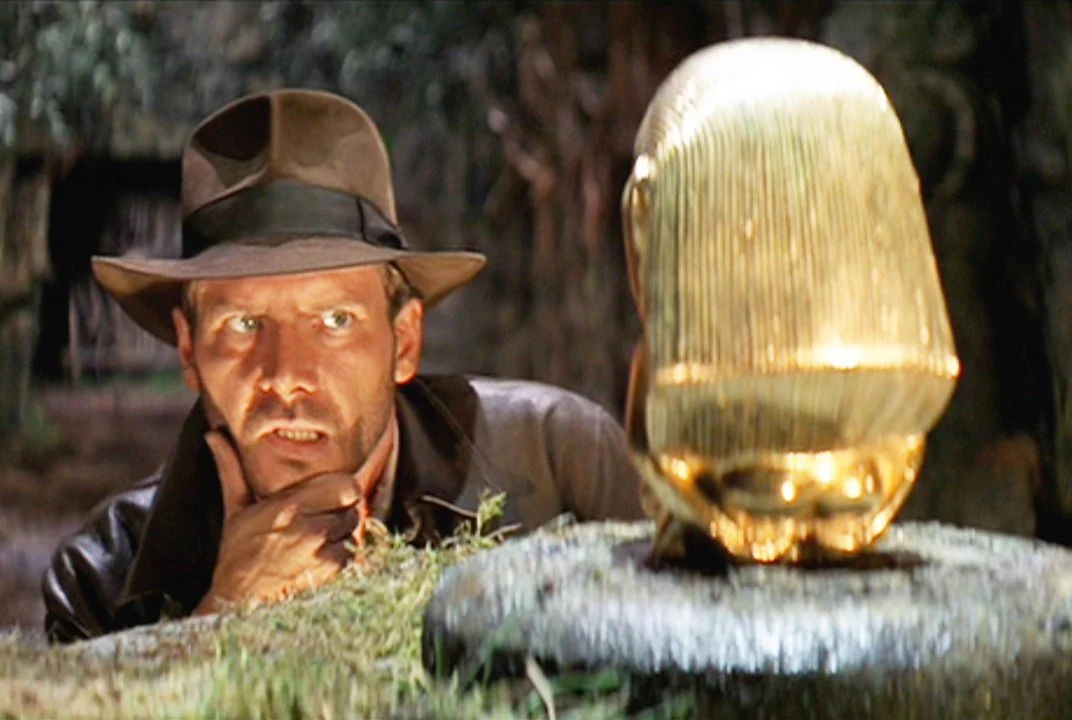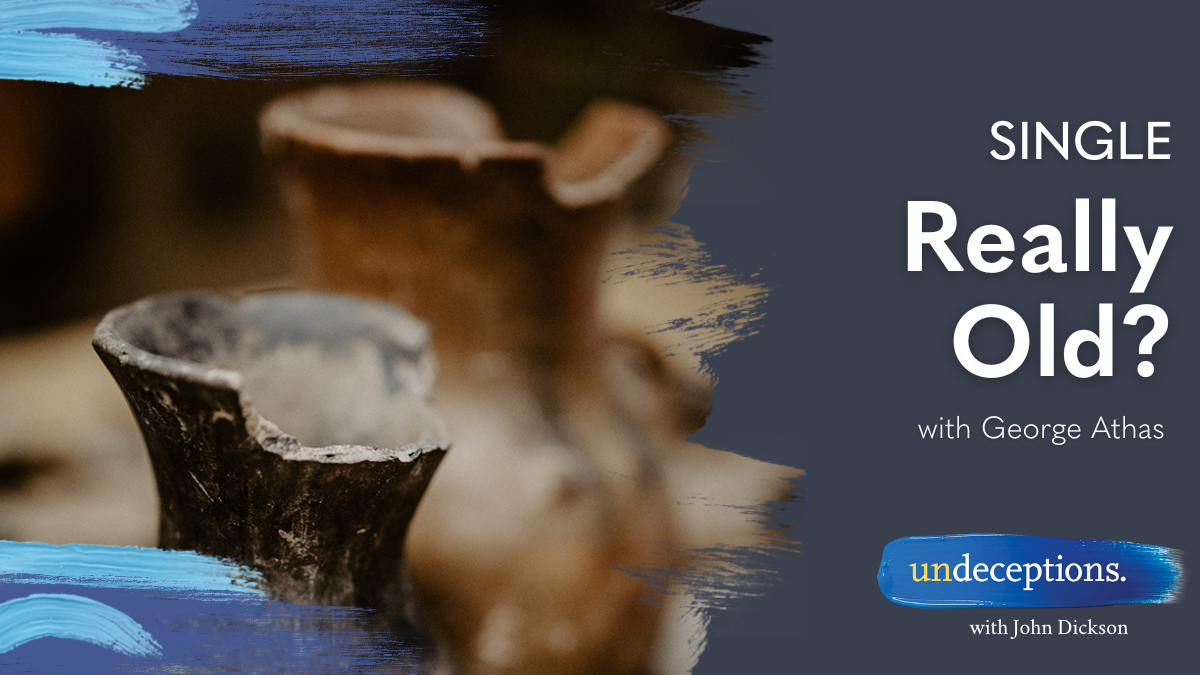By George Athas, adapted by Alasdair Belling from ‘Really Old‘ on the Undeceptions podcast.
The video is a clip from the Associated Press, and we’re listening to Joe Uziel, director of the Israel Antiquities Authority. The document he’s talking about is known as the Ishmael Papyrus. And with not much more than three words on a scrap of really old papyrus, its discovery set the archaeological world aflame back in September.
The papyrus was purchased by an American woman in the 1960s from the curator of the Rockefeller Museum and an antiquities dealer. She took it back home, framed it and hung it in her home. Several years later, she passed away and passed it down to her son.
The document became known to a prominent epigraphist, who then contacted the anti-theft unit of the Israel Antiquities Authority. And together they contacted the individual in the U.S. who came to visit our unit and our laboratories, and came to the conclusion that this was the right place to care for this important document, one of “only three of its kind in the world”.
“To Ishmael, send…” reads the beginning of the fragmented, four-line inscription.
The papyrus – a material like thick paper that was used as a writing surface in ancient times – has been dated to about 600BC, the last few decades of the biblical kingdom of Judah. The inscription was written in an early Hebrew script and, if it is authentic, is remarkable for several reasons.
Firstly, its very existence is cause for celebration. Papyrus usually disintegrates after a short time, unless it’s kept in the driest of desert conditions. This scrap survived for 2600 years!
Secondly, the age of the papyrus makes it tempting to identify the Ishmael mentioned on it with Ishmael, son of Nethaniah. That Ishmael was a military commander and member of the Davidic royal family, which ruled the kingdom of Judah in Old Testament times. He’s mentioned in the Old Testament books of 2 Kings and Jeremiah.
But is the Ishmael mentioned on this scrap of papyrus that Ishmael? Well, we just don’t know. The fact is, there were probably dozens, maybe even hundreds of Ishmaels in 600 bc.
As exciting as this scrap of papyrus is, there are many more questions about it that should give us pause. For a start, we don’t actually know where it came from.
As reported by the Associated Press, it was in the possession of a random woman, who took it back to America after claiming to have come by it in the 1960s during her travels in Israel and Palestine. But she has since died, so we can’t ask her more detailed questions.
And that’s the problem. If we can’t verify exactly where an ancient artefact came from, we need to be suspicious.
This kind of backstory is not unique. Fake antiquities and the illegal trade of real antiquities is big business. Not only does it make some people a lot of money, it can also literally rewrite history. Every artefact found in the Middle East has political value. There is power in being able to say, “My ancestors lived in this place in antiquity, and here’s the proof,” or “See, my religion has real historical backing to it”
With so much riding on such small fragments of our past, perhaps you’d like to know; How do we know our old stuff is actually old?
In this question, suspicion is our friend. As are rigorous processes and qualified experts.
Archaeologists work in authorised, controlled conditions. Their backgrounds have been scrutinised in order to receive the legal permits that allow them to dig in the first place. We don’t want just anyone putting a spade into the ground! These qualified archaeologists meticulously document what they do. When an artefact is found under such conditions, we can be confident that it’s authentic and old.
The Ishmael Papyrus was not ‘discovered’ on an archaeological dig. At least, not any time recently. There is still not a confirmed and documented chain of custody for the Ishmael Papyrus, that would give us confidence in its origins. That sort of thing takes time and scrutiny.
The news reports of the Ishmael Papyrus suggested it was one of only three first temple papyri to have been discovered. Yet Christopher Rollst, considered by many (including me) as the Yoda on archaeological finds like this, reminded us in one opinion piece that two of the three papyri still have this type of questionable, or foggy backstory.
Only one – known as P.Mur or the Murabba‘at Papyrus was found in a controlled archaeological dig. That papyrus was found by archaeologists in one of four caves of the Wadi Murabba‘at in the Judean Desert in 1951 and published in 1961 after intense study. The other two were found elsewhere – the Ishmael Papyrus on the wall of a woman’s home and the so-called Jerusalem Papyrus was seized from a band of antiquities looters who were trying to sell it. Plenty of antiquities that turn out to be properly old are found outside an actual dig – but the process of tracing their origins is a long one and often ends in disappointment.
Then, of course, you have all the ways we can determine an artefact’s age once we know where we found it. As a general rule (though with a few exceptions), the further down in the ground something is found, the older it probably is. That’s because ancient people usually built on top of old buildings and ruins, and so the ages accumulated in successive layers, one on top of the other—what archaeologists call “strata”.
But the depth only gives us a relative timeline. It doesn’t tell us the century or year in which something was built.
That’s where pottery comes in. Ancient people used a lot of pots—for cooking, storing, transporting. And pottery is easily broken, so there were a lot of pottery fragments strewn all over the place in the ancient world.
When archaeologists started to refine their methods in the early twentieth century, they were finding pottery in a similarly stratified way to buildings. And they noticed patterns in the way pots were made: one layer in the ground would have pots of one particular shape and decoration, while the pots found in another layer had a slightly different shape and decoration.
In this way, archaeologists were able to trace a chronology of pottery development, and this has become one of the standard ways of being able to date a layer in the ground. It is particularly useful in figuring out how ancient sites relate to each other, because the pottery gives us a common thread for dating them all. Pots, of all things, have given us the bigger historical picture of ancient times.
But the most reliable way of dating something is writing: an inscription carved in stone, a note written on a papyrus, or even on the back of a pottery fragment (broken pots were also useful as ancient post-it notes) … these are incredibly valuable. A piece of writing is like a soundbite from the ancient past.
Of course, even inscriptions have to be carefully interpreted. Many years ago, I studied the Tel Dan Inscription, an ancient Aramaic inscription from around 800 bc, which is our first evidence outside the Bible for King David. Unfortunately, the fragments of the inscription are broken off at some of the most critical points, like at the very beginning or end of someone’s name. And names are some of the most valuable pieces of information we could ever have for deriving absolute dates for things.
When archaeologists first found the inscription, they were so excited to find something referring to David that they quickly jumped to conclusions. In fact, so keen were they to match the inscription with what’s in the Bible that they quickly filled in the partial names based purely on their initial hopes and hunches, and published a reconstruction and interpretation before they’d even finished excavating the find site. While they were right in identifying a reference to the “House of David” in the inscription, they were a little too hasty in filling out the partial names. They also got the arrangement of the fragments wrong, missed a letter which scuttled their interpretation, and then forgot to check whether their later excavations confirmed their proposed date for the inscription. As it turned out, they were off by half a century. That’s not too bad for something 2800 years old, but it’s still a critical difference.
The Tel Dan Inscription shows us how much excitement there can be when something can be connected to the Bible. Of course, it is exciting! But it doesn’t override our need to do painstaking analysis of the artefact itself, as well as the context in which it was found. Interpreting an artefact without interpreting its context is like trying to contain water without a glass—it can end up creating a bit of a mess. It’s far better if we contain our excitement and get multiple qualified, experienced hands to consider all the information at our disposal, even if that means we have to wait a few years before we get the whole picture.
That kind of Bible-induced enthusiasm can sometimes make us lose our objectivity. It even drives some to produce sophisticated fake artefacts.
In 2015 a CNN documentary called ‘Finding Jesus’ took a close look at the case of the James Ossuary. An ossuary is a small burial box for holding the bones of dead people.
The so-called ‘James Ossuary’ bears an inscription on one side, saying it held the bones of James, the brother of Jesus, from the first century ad. Naturally, it caused a sensation when it was announced to the world. But this ossuary had one of those foggy backstories.
It turns out the ossuary itself was probably genuinely first century, though where exactly it came from is unknown. But a forger took this genuine artefact and carved a fake inscription on it, knowing that the name of James, brother of Jesus, would make the artefact immensely valuable. The forger even dusted ancient material into the fake inscription to make the writing look just as ancient as the ossuary itself. It was a masterful attempt at literally creating history, and was only exposed through rigorous scientific analysis and a police investigation.
All forgeries have one thing in common: they have foggy backstories. They don’t come from the unambiguous controlled conditions of an authorised excavation. It’s why it’s always important for archaeologists to be as transparent about things as possible, and for analysts to curb their enthusiasm as they do the cold, clinical work of evaluating and interpreting finds. It’s the only way we can be sure our old stuff is actually old, and prevent our imaginations getting the better of us.
So what about the Ishmael Papyrus? Is it old? Is it authentic?
Well, we really need more time to do some thorough analysis to know. News sites will often announce these kinds of artefacts with fanfare and sensation. But behind the hype of the headlines, you can be guaranteed that there are a host of experts calling for calm and cooler heads. Analysing finds like the Ishmael Papyrus actually takes years of work. Scientific tests need to be performed, validated, and discussed by a community of scholars before any kind of conclusion can be reached. That’s the work that reassures us that our old stuff is, really and truly, old.
So, stay tuned.
Dr Geroge Athas is the Director of Research Old Testament and Hebrew at Moore Theologocal College, Sydney. George has done a huge amount of research on the Tel Dan Inscription, a fragmentary stele that dates to the 9th Century BC. It’s considered the most important – and controversial – inscription found in Israel in recent years. And George wrote the first book about it.

Want to be further undeceived?
Check out our network of podcasts and articles in the Undeceptions Library.











































